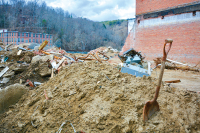The time to act on climate change is now

By Steve Wall • Guest Columnist | The place — Canton; the time — 7 a.m.; the date — September 9, 2004.
Mayor Pat Smathers and I walked down Park Street in disbelief. Colonial Theater, Canton Medical Office, police and city offices had all flooded with up to seven feet of water from the Pigeon River. Hurricanes Ivan and Frances hit within a week and left a grim mark on Haywood County. That was 2004.
The previous record flood was back in 1916, when two hurricanes also dumped about 20 inches of rain on WNC. The 1916 and the 2004 disaster were each called a “100-year event.” But here we are only 17 years later. The loss of life and property in Haywood County has been terrible.
Quick responses from heroic rescue teams and communities pulling together have helped Haywood County survive. But six of our neighbors did not.
A positive outcome of the 2021 flood was the success of the flood plain “escape valve” created along the river in Clyde after the 2004 event. I drove along Thickety Road after the recent flooding and saw the power of the water that had rushed through. Trees that had been planted — many by Haywood Waterways volunteers — were at a 4-degree angle. Mud covered much of the parkland. Yet the project helped. Clyde suffered far less damage than in 2004.
2020 was the most active storm season ever. There were 30 named storms, and we ran out of alphabet letters to name them. Letters from the Greek alphabet were needed. We are barely halfway through this hurricane season and the rapid global warming that causes increased storm intensity continues.
Related Items
Up to now, it may have seemed hard to believe that global climate changes affect us right here.
We cannot afford to ignore the fires and 100-degree heat in faraway Siberia. The havoc this wreaks on the jet stream is real. This globally circulating river of air affects our climate patterns dramatically and is becoming more volatile as the Arctic region heats up four times faster than the rest of the planet.
We cannot afford to ignore the first warming rainfall ever atop the 10,000-foot thick Greenland ice sheet. It is melting away and contributing to the rising and heating of the oceans and increasing the conditions that cause hurricanes to intensify.
And can we in Western North Carolina simply turn the channel and ignore the drought and inferno in the Western U.S.? Is there not a risk of drought and fire here in our beautiful mountains, as occurred only a few years ago?
New Orleans suffered 1,800 deaths after Hurricane Katrina in 2005. But, after $15 billion were invested in re-engineering the levees, this year’s even more powerful storm, though terribly destructive, was far less deadly than Katrina. This demonstrated that we can as a society take steps — as was done in Clyde on a modest scale and in New Orleans on a massive scale — to prepare for and lessen the impact of the next “100-year event.”
How our fields are planted, how our homes, businesses and roads are built, how our rivers and streams are managed, how we obtain electric power, will all play a critical role in the ability of Western North Carolina to prepare for and lessen the impact of the next, inevitable climate challenge. It will not take another 100 years — perhaps not even 17 years — to happen.
We have many organizations and experts in the management of waterways, agriculture, construction and sustainable energy in our region. Perhaps it is time for Haywood County commissioners to establish a panel of experts — an Environmental Advisory Taskforce — to guide our county into a future of preparedness. This is being done in communities across America.
The steps we take in Haywood County will be part of a growing worldwide effort that can have an impact on the 24 billion tons of carbon being dumped into the earth’s atmosphere by the burning of coal, gas and oil products every year. And proper soil and forest management actually helps pull carbon dioxide out of the atmosphere.
Worldwide, the wholesale destruction of the oxygen-producing and carbon absorbing rain forests continues. Vast fields of oceanic plankton produce about 50% of the oxygen on this planet. They are being decimated by increased sea water temperatures. These are just two of the serious challenges to our planet’s livability. We must do what we can — and soon — to prevent the death and destruction that will inevitably come with increasing climate catastrophes.
Steps we can take now at the federal, state and local levels will lessen the future misery experienced by our neighbors, our children, grandchildren, and ourselves. The time is now.
(Dr. Wall practiced pediatrics in Haywood County for 30 years. He is a member of the Western North Carolina Climate Action Coalition.)









